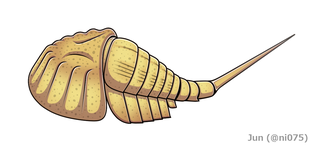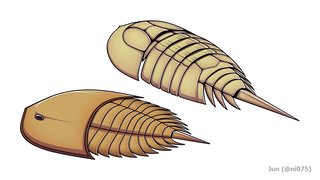 W
WPlanaterga is a clade of prosomapod euchelicerates including several synziphosurid genera and the group Dekatriata. Planaterga is defined by the opisthosoma with tergites broadest at third or fourth and lacking enlarged axial nodes, carapace with reduced genal spines, as well as somite VII with reduced appendages and microtergite.
 W
WBembicosoma is a genus of synziphosurine, a paraphyletic group of fossil chelicerate arthropods. Bembicosoma was regarded as part of the clade Planaterga. Fossils of the single and type species, B. pomphicus, have been discovered in deposits of the Silurian period in the Pentland Hills, Scotland. Bembicosoma had been tentatively assigned as an eurypterid before its synziphosurine affinities revealed.
 W
WBunodes is a genus of synziphosurine, a paraphyletic group of fossil chelicerate arthropods. Bunodes was regarded as part of the clade planaterga. Fossils of the single and type species, B. lunula, have been discovered in deposits of the Silurian period in Ludlow, England. Bunodes is the type genus of the family Bunodidae, the other genera of the same family being Limuloides.
 W
WBunodidae is an extinct family of synziphosurine chelicerates that lived in the Silurian. Bunodidae is classified inside the clade Planaterga alongside Pseudoniscidae and Dekatriata. Bunodidae is composed by two genera, Bunodes and Limuloides.
 W
WCyamocephalus is a genus of synziphosurine, a paraphyletic group of fossil chelicerate arthropods. Cyamocephalus was regarded as part of the clade Planaterga. Fossils of the single and type species, C. loganensis, have been discovered in deposits of the Silurian period in Lesmahagow, Scotland. Cyamocephalus is one of the two members of the family Pseudoniscidae, the other being Pseudoniscus. Cyamocephalus differ from Pseudoniscus by the fused tergites of 6th and 7th opisthosomal segments.
 W
WLimuloides is a genus of synziphosurine, a paraphyletic group of fossil chelicerate arthropods. Limuloides was regarded as part of the clade Planaterga. Fossils of the genus have been discovered in deposits of the Silurian period in the United Kingdom and potentially in the United States. Limuloides is one of the two genera of the family Bunodidae, the other being the type genus Bunodes. Limuloides characterized by a carapace with radiated ridges and serrated lateral regions, as well as an opisthosoma with rows of nodes. Limuloides was once though to have lateral compound eyes on its carapace, but later investigation did not find any evidence of it.
 W
WPasternakevia is a genus of synziphosurine, a paraphyletic group of fossil chelicerate arthropods. Pasternakevia was regarded as part of the clade Planaterga. Fossils of the single and type species, P. podolica, have been discovered in deposits of the Silurian period in Podolia, Ukraine.
 W
WPseudoniscidae is an extinct family of synziphosurine chelicerates that lived in the Silurian. Pseudoniscidae is classified inside the clade Planaterga, alongside Bunodidae and Dekatriata. Pseudoniscidae is composed by two genera, Cyamocephalus and Pseudoniscus.
 W
WPseudoniscus is a genus of synziphosurine, a paraphyletic group of fossil chelicerate arthropods. Pseudoniscus was regarded as part of the clade Planaterga. Fossils of the genus have been discovered in deposits of the Silurian period in the United Kingdom, the United States and Estonia. Pseudoniscus is one of the two members of the family Pseudoniscidae, the other being Cyamocephalus.